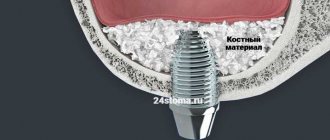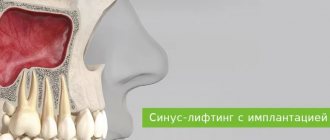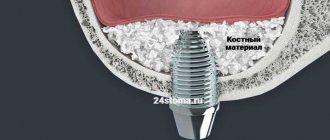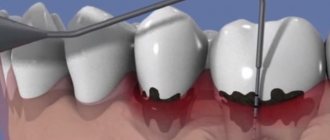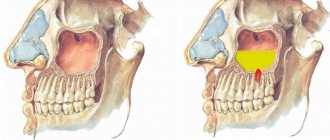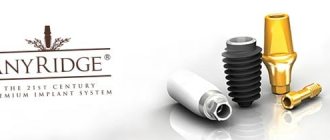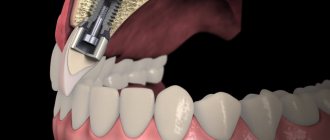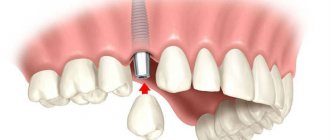+7 (metro Kurskaya)
+7 (Barvikha)
Your comfort and safety are very important to us, so in order for you to maintain self-isolation, we have introduced online consultation with doctors.
Sign up
To receive an online consultation, fill out your information:
Take a short test and calculate the cost online in 20 seconds!
Take the test
Having chosen implantation as a method of restoring lost teeth, even at the stage of preparation for this operation, you may hear from your doctor that you need a preliminary sinus lift.
This term can be quite confusing to a person preparing for dental implants for the first time. So that you know what a sinus lift is and why it is needed before implantation, we have prepared detailed material on this operation.
Let's start by looking at the definition that the term has. Sinus lifting is the name of osteoplastic surgery, during which the bottom of the maxillary sinus is raised.
The maxillary sinus (sinus, cavity) is a paired organ located in the bone of the upper jaw and performs important functions: it is involved in the olfactory function, maintains healthy pressure in the nasal cavity, and is important for speech function.
Osteoplasty or osteoplastic surgery is a special type of surgery in which bone tissue is built up.
Take a short test and calculate the cost of treatment!
Take a short test
- Selection of implants
- Which tooth is missing?
- How long has the tooth been lost?
- Missing teeth
- Cost calculation
×
Manukyan Artavazd Genrikovich
Chief physician of the clinic
When performing a sinus lift operation, the lower wall of the maxillary sinus (bottom) is raised, which is located below the level of the nose and this makes it possible to obtain sufficient height and thickness of the bone for implantation.
IMPORTANT: The height and thickness of the bone are indicators that are of paramount importance for high-quality fixation of the implant in the jaw. If the bone is too thin and loose, the implant will not hold in it.
Why is surgery needed?
The main purpose for which a sinus lift is prescribed is to obtain the required volume of bone tissue for strong fixation of a dental implant in the jaw. Sinus lifting is recommended before implantation of the upper anterior teeth and in the event that the height and density of the natural bone is not enough for high-quality installation of artificial roots.
IMPORTANT: If you have lost a tooth due to injury or were forced to remove it due to an advanced disease, we recommend that you do not delay either prosthetics or implantation. The longer a tooth is missing, the more the bone thins in the place where it used to be.
A timely visit to a doctor will save you from the need for additional operations, including sinus lift.
Why does bone atrophy occur?
In 75-80% of patients, the alveolar part of the jaw has a deficiency along the horizontal or vertical surface. In such cases, implantation is not possible.
Alveolar processes are resorbed when exposed to the following factors:
- chronic inflammatory processes in a decaying tooth;
- surgical tooth extraction, in which the dental surgeon destroys the tooth root with the alveolar part;
- structural features of the jaw;
- the absence of a tooth for more than six months suggests atrophy of the dental bone due to the cessation of constant pressure on it during chewing.
Based on the data on the deficit in the width/height of the jaw bone tissue, the dentist-implantologist chooses a plastic surgery tactic for restoration. To obtain information about the state of the bone volume of the jaws, X-rays, computed tomography and MRI are done. Such a study provides a layer-by-layer picture of the required alveolar area with an accurate determination of the lack of bone fragments. Then the doctor determines the type of further manipulations.
Sinus lift techniques and surgical options
There are two main methods of this osteoplastic surgery - open and closed sinus lift. Which method will be used in a specific clinical case - only an implantologist can answer this question, after diagnosis and decision - which implants will be used for dental restoration.
Having decided on the type and length of dental implants, the doctor will receive an accurate idea of how high the bone needs to be built up in the area where the artificial roots are implanted. If it is necessary to grow the bone to a height of up to 4 millimeters, a closed operation is performed. If the bottom of the maxillary sinus needs to be raised by five or more millimeters, a decision is made to perform an open sinus lift.
Get treatment plan and prices
Point to the image, select the desired tooth and the required service.
A specialist will contact you and advise on all questions and cost of treatment Select a tooth
Calculation of the cost of treatment:
Open sinus lift
This technology makes it possible to increase the height of the bone to significant levels, but is very traumatic and more difficult for patients to tolerate.
Open sinus lifting is prescribed for:
- With severe atrophy (thinning) of bone tissue;
- If necessary, grow the bone to a height of more than five millimeters;
- If more than two dental implants are to be installed.
Technologies
The operation is carried out according to two schemes - classical, in which the implants will be implanted into the bone 5-6 months after the sinus lift, and also using one-stage technology, which involves the immediate implantation of artificial roots.
Classic technology
The patient is given anesthesia and when it begins to take effect, the surgeon will make incisions in the mucous membrane on the outside of the upper jaw gum. The doctor will lift the cut flap of tissue and then make cuts in the bone with a special tool, allowing access to the bottom of the maxillary cavity. The doctor will then place bone material there.
IMPORTANT: Bone material is a special material that is used to accelerate the healing of injured tissue, as well as accelerate the growth of natural bone.
Ask your doctor in detail about bone material, as it comes in different types and origins (biological, synthetic). Both the price of the operation and the recovery time after it will depend on the type of bone material.
A special membrane is placed on top, which will protect the intervention area from infection.
After this, the doctor will return all the cut tissue flaps to their place and will close the wound and apply stitches.
Sinus lift with immediate placement of dental implants
This technique has an obvious advantage - the patient does not have to wait six months before implantation, which means that the overall implantation time will be reduced. The technique for performing such a sinus lift will be similar to that described above. The only difference is that after raising the bottom of the maxillary sinus, the doctor will immediately install dental implants.
It is important to take into account one more feature of a one-stage sinus lift: the risks of adverse reactions and complications after it are somewhat higher than when using classical technology.
Complications and possible contraindications to open sinus lift
Experts openly tell patients that open sinus lift is an osteoplasty technology that does not exclude fairly high risks of complications. The most common and severe complication after the intervention is a rupture of the mucous membrane. Other complications are also possible:
- Heavy bleeding;
- If the doctor does not have enough experience in performing osteoplasty, there is a high risk of injury to the roots of adjacent teeth.
The operation is not recommended for patients with diabetes mellitus or pathologies that cause disturbances in the blood clotting process.
Closed sinus lift
Most often it is carried out simultaneously with the implantation of implants. The technology is recognized by experts as gentle and has minimal risks of complications. Implantologists recommend resorting to closed surgery under the following circumstances:
- The bone needs to be increased to a height of no more than 4 millimeters;
- The height of the natural bone above the maxillary sinus is no less than 5 millimeters.
Such bone height indicators are required for high-quality primary stabilization of implanted implants.
Also, the technique is used mainly in cases where dental restoration requires the implantation of no more than two implants in the projection of the maxillary sinus. The operation is carried out as follows: first, the doctor will drill out the jaw bone with a drill to obtain a bed for installing the implant. Then he will gently move the mucous membrane in the maxillary cavity so that it rises up. As a result of this action, a sufficient amount of space will be freed up for the placement of bone material. The doctor will fill the empty space with bone chips, and then install implants and stitch the wound.
Postoperative period
The main task at this time is to prevent displacement of the injected bone growth stimulator and prevent inflammation. You will receive the necessary medications for this period in our clinic.
Healing of soft tissue takes place within a week, and the implanted material takes a month to engraft and mature. The greater the missing bone volume, the more bone stimulator will be used, the longer the period of maturation of new bone. During this time, you should be under the supervision of a doctor with ten-minute visits once a month, follow the recommendations and beware of respiratory diseases.
Are there any alternative solutions?
The need for a sinus lift does not arise in all cases. It will not be required if dental restoration is carried out using basal implantation technology, which uses a special type of implants.
There is no need for a sinus lift when using All-on-4 implantation technology. But there is one caveat: surgery according to this protocol is applicable only to patients with a completely toothless jaw.
Would you like to receive detailed advice on sinus lifting from qualified and experienced specialists? Come to an appointment with the doctors at our clinic in Moscow - “Aesthetica”! The initial consultation with a specialist is free and during the consultation you will receive detailed answers to all your questions about dental implantation.
To make an appointment, you just need to dial our clinic’s phone number or leave a request for a call back on our website.
Take a short test and calculate the cost of treatment!
Take a short test
- Selection of implants
- Which tooth is missing?
- How long has the tooth been lost?
- Missing teeth
- Cost calculation
×
Manukyan Artavazd Genrikovich
Chief physician of the clinic
Articles on the topic
What tests to take before dental implantation in Moscow
The necessary tests for dental implantation are determined individually after the initial examination.
The doctor takes into account the condition of the oral cavity and the presence of concomitant chronic diseases...... Read #dental implantation
Nobel implants – Nobel Biocare, turnkey price, reviews, installation
Nobel implants are developments of the Swiss manufacturer Nobel Biocare, celebrating their half-century anniversary.
Biocare is rightfully considered one of the leading implant manufacturers. Nobel products….. Read #dental implantation
Turnkey dental implantation: description of the procedure, features and benefits for patients
Implantation is a modern and effective method of restoring lost teeth.
During the operation, the patient is implanted in the area of the lost tooth with an implant - an artificial root, onto which it is then fixed..... Read #dental implantation
Implantation of chewing teeth: subtleties of the process, technology, prices
We will tell you about implantation of chewing teeth in this article.
After reading the material, you will learn about the features of implantation of chewing teeth, what implants and crowns are needed….. Read
How to avoid risks and complications?
Although the sinus lift has been used worldwide for over 30 years, it is a technically challenging procedure. Additional complications may arise from anatomical formations in the maxillary sinus, for example, septa dividing the sinus into several cells. The membrane can be so thin that it ruptures during a sinus lift from a banal exit through the nose.
How to avoid health risks if you are indicated for a sinus lift? The main thing is to trust a qualified implantologist who will take the correct treatment tactics even in a difficult case. Be prepared for the fact that the treatment period for severe bone tissue atrophy can be significant, a year to a year and a half.
The best bone grafting is the one that doesn't take place. If it is possible, without compromising the reliability of the treatment plan, to avoid bone grafting, then you can install shorter implants or bypass the maxillary sinus by installing implants at an angle.
